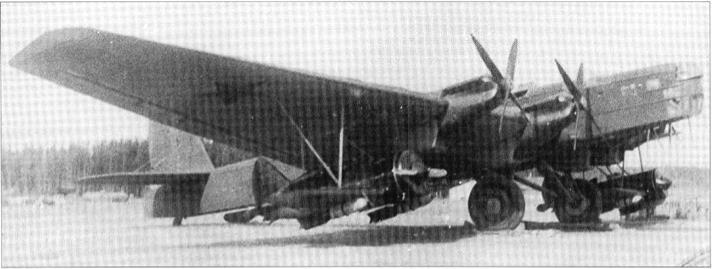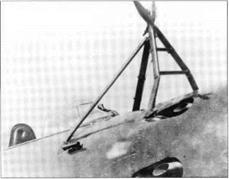Vakhmistrov Zveno
Purpose: To enable a large aircraft to carry one or more small ones long distances, for example to attack targets that would otherwise be out of reach.
Design Bureau: Not an OKB but engineer Vladimir Sergeyevich Vakhmistrov working at the LII (flight research institute).
In 1930 Vakhmistrov suggested that a cheap glider might be used as an aerial gunnery target, and he quickly perfected a way of carrying such a glider above the upper wing of an R-l reconnaissance aircraft and releasing it in flight. This gave Vakhmistrov the idea ofusing a large aircraft to carry a small one on long – range flights over hostile territory. The small aircraft could either be fighters to protect a large bomber, or bomb-carrying attack aircraft or camera-carrying fast reconnaissance aircraft which could make a pass over a target while the parent aircraft stood off at a safe distance. In each case the difficult part was hooking on again for the long flight home. After presenting the WS and LII management with calculations Vakhmistrov received permission to try out his idea. This led to a succession of Zveno (link) combinations:
Z-l
This featured a twin-engined Tupolev TB-1 bomber carrying a Tupolev I-4 fighter above each wing. The fighters were of the I-4Z version, three of which were converted for these experiments with short stub lower wings and attachment locks on the landing gear and under the rear fuselage. The bomber was provided with attachments for the Zveno aircraft above each wing: two small pyramids for the landing gear and a large tripod for the rear – fuselage attachment.
The first flight took place from Monino on 3rd December 1931. The TB-1 was flown by AI Zalevskii and A R Sharapov, with Vakhmistrov as observer. The fighters, with ski landing gears, were flown by V P Chkalov and A S Anisimov. The take-off was made with the fighter engines at full power. The TB-1 copilot forgot the release sequence and released Chkalov’s axle before releasing the aft attachment, but Chkalov reacted instantly and released the rear lock as the fighter reared nose-up. The second fighter was released correctly. For a few seconds the TB-1 flew with no tendency to roll with an I-4Z on one wing.
Z-la
First flown in September 1933, this comprised the TB-1 carrying two Polikarpov I-5 fighters. The latter were fitted with a reinforcing plate under the rear fuselage carrying the rear holddown, but had no special designation. The pilots were P M Stefanovskii (TB-1) and I F Grodz’ and V K Kokkinaki (I-5).
Z-2
This was the first of the more ambitious hookups using a TB-3 as parent aircraft. The bomber was an early TB-3/4 M-l 7, and it was given attachments for an I-5 above each wing and a third above the fuselage with its wheels on a special flat platform. On the first test in August 1934 the TB-3 was flown by Zalevskii and the fighters by T P Suzi, S P Suprun and T T Al’tnov.
Z-3
This combination would have hung a Grig – orovich I-Z monoplane fighter under each wing of the TB-3. It was not flown.
Z-4
No information.
|

![]()

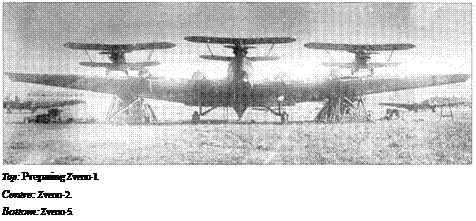

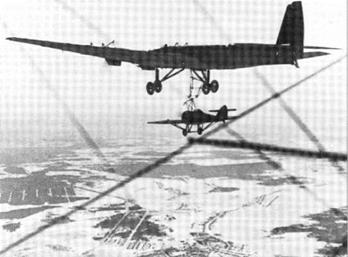 Z-5
Z-5
This was the first attempt to hook back on. The parent aircraft was again the TB-3/4 M-l 7, and the fighter was an I-Z fitted with a large suspension superstructure of steel tubes, plus a curved upper guide rail terminating in a sprung hook releasable by the pilot (almost identical to the arrangement used on the airship-borne US Navy F9C Sparrowhawks). This was designed to hook on a large steel-tube trapeze under the bomber, which was folded up for take-off and landing. V A Stepanchy- onok flew the I-Z on several tests with the bomber flown as straight and level as possible by Stefanovskii. The first hook-on took place on 23rd March 1935; this was a world first.
Z-6
The final combination of the original series was the mating oftwo I-16 monoplane fighters hung under the wings ofthe TB-3. The fighters were provided with local reinforcement above the wings to enable them to be hung from sliding horizontal spigots on large tripod links of streamlined light-alloy tube pin-jointed to the bomber’s wing structure. Bracing struts linked the bomber to a latch above the fighter’s rear fuselage, and one ofthe fighters (M-25A-engined No 0440) was photographed with a lightweight pylon above the forward fuselage to pick up under the bomber’s wing. The first test took place in August 1935; Ste – fanovskii flew the TB-3 and the fighter pilots were K K Budakov and AI Nikashin.
Aviamatka
Named ‘mother aircraft’, this amazing test, not part of the original plan, took place in November 1935. The TB-3/4M-17 took off from Monino with an I-5 above each wing and an I-16 below each wing. At altitude it folded down the under-fuselage trapeze and Stepan – chenok hooked on the I-Z, making a combination of six aircraft of four types all locked together. After several passes all the fighters released simultaneously. By this time Vakhmistrov had schemes for up to eight fighters of later types all to be carried by large aircraft such as the full-scale VS-2 tailless bomber projected by Kalinin. Instead Stalin’s ‘terror’ caused the whole effort to wither, but there were still to be further developments.
SPB (Russian initials for fast dive bomber) This was a special version of the Polikarpov I-16 equipped with a rack to carry an FAB-250 (bomb of 250kg, 551 Ib) under each wing. Such an aircraft could not have safely taken off from the ground. In 1937 a later TB-3/4AM – 34RN was made available, and two SPB aircraft were hung under its wings. The first test took place on 12th July 1937, the TB-3 being flown by Stefanovskii and the dive bombers by A S Nikolayev and IA Taborovskii.
Z-7
In November 1939 one final combination was flown: the TB-3/4AM-34RN took off with an I – 16 under each wing and a third hooked under the fuselage in flight (with severe difficulty). The I-16 pilots were Stefanovskii, Nyukhtikov and Suprun.
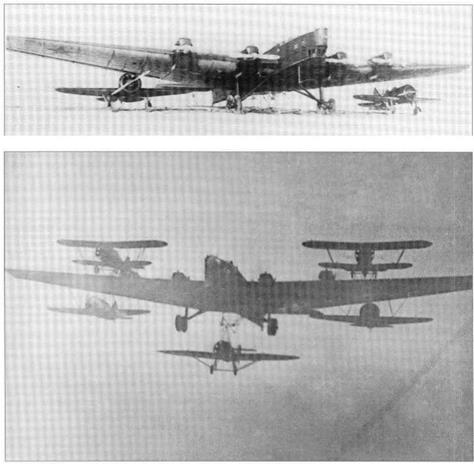
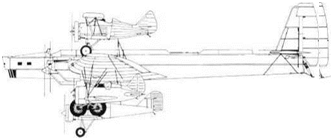 |
|
In early 1940 the WS decided to form a Zveno combat unit. Based at Yevpatoriya, this was equipped with six modified TB-3/4AM – 34RN and 12 SPB dive bombers. During the Great Patriotic War a famous mission was flown on 25 th August 1941 which destroyed the Danube bridge at Chernovody in Romania, on the main rail link to Constanta. Surviving SPBs flew missions in the Crimea.
|
|
![]()
